The Vitality of Public Space and the Effects of Environmental Factors in Chinese Suburban Rural Communities Based on Tourists and Residents
Abstract
1. Introduction
2. Materials and Methods
2.1. Study Area
2.2. Study Data
2.2.1. Environmental Characteristics
2.2.2. Space Vitality
2.3. Analysis Method
2.3.1. Quantified Space Vitality
2.3.2. Screening of Environmental Factors
2.3.3. Geographical Weighted Regression Analysis
3. Results
3.1. The Spatial Distribution of Space Vitality
3.1.1. Residents
3.1.2. Tourists
3.2. Spatial Autocorrelation Analysis
3.3. Selection of Explanatory Variables
The Relationship between Space Vitality and Environmental Factors
4. Discussion
4.1. How Do the Public Spaces in Suburban Rural Communities Affect Users?
4.2. Vitality Optimization Strategy for Public Spaces in Suburban Rural Communities
4.3. Limitations and Insights for Future Research
5. Conclusions
Author Contributions
Funding
Institutional Review Board Statement
Informed Consent Statement
Data Availability Statement
Conflicts of Interest
Appendix A
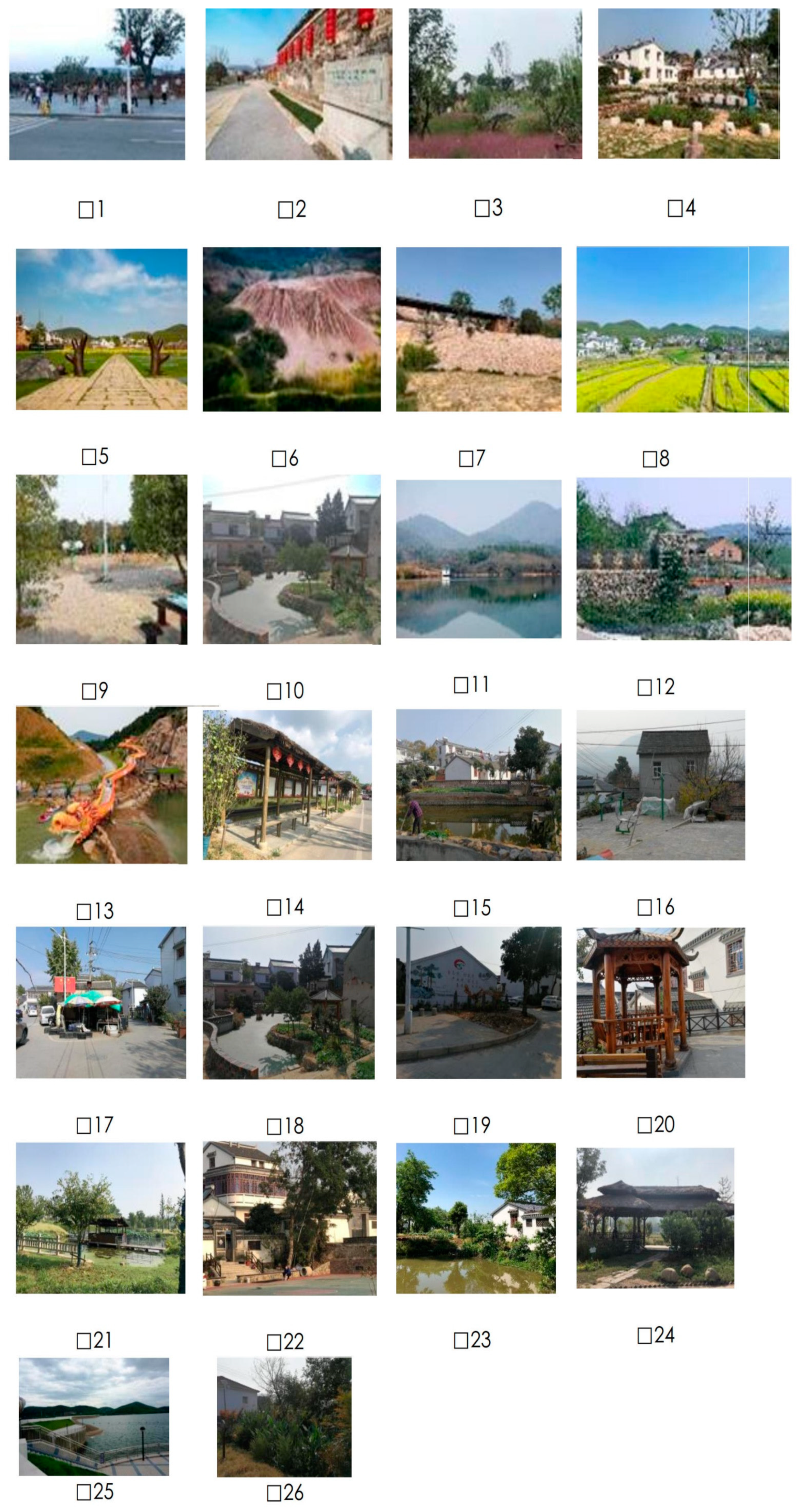
References
- Hara, T.; Ono, A. Marginal settlements and regional regeneration. Marg. Settl. Reg. Regen. 2009, 44, 69–70. [Google Scholar]
- Henke, R.; Vanni, F. Peri-urban agriculture: An analysis of farm typologies in Italy. New Medit Mediterr. J. Econ. Agric. Environ. 2017, 16, 11–18. [Google Scholar]
- Long, H.; Liu, Y.; Li, X.; Chen, Y. Building new countryside in China: A geographical perspective. Land Use Policy 2010, 27, 457–470. [Google Scholar] [CrossRef]
- Jokinen, M.; Sippola, S. Social sustainability at tourist destinations—Local opinions on their development and future in northern Finland. Univ. Lapland Arct. Cent. Rep. 2007, 50, 89–99. [Google Scholar]
- Tosun, C. Host perceptions of impacts: A comparative tourism study. Ann. Tour. Res. 2002, 29, 231–253. [Google Scholar] [CrossRef]
- Chen, Y. Research on Public Space Design of New Rural in Handan Area. Master’s Thesis, Hebei University of Engineering, Handan, China, 2017. [Google Scholar]
- He, Y. The practice and experience based on the construction of public space and facility. Arch. Tech. 2017, 37, 68–71. [Google Scholar]
- Liu, Y.; Wu, H.M. Discussion on the New Mode of Rural Endowment for the Aged—Behavioral Characteristics Define the Design Technique of Public Space Classification. Jiangsu Constr. 2019, 39, 92–96. [Google Scholar]
- Szeszuła, W. Kryteria oceny rozwiązań przestrzennych zespołów zabudowy jednorodzinnej. [The criteria for the assessment of spatial solutions in the family housing]. Archit. Artibus. 2010, 2, 76–84. [Google Scholar]
- Liu, Y.; Zhao, Z. The spatial characteristics and formation mechanism of multigroup conflicts in ethnic tourism community from the perspective of residents: A case study of Xijiang Qianhu Miao Village. Geogr. Res. 2021, 40, 16. [Google Scholar]
- Jiang, D. The Theory of City Form Vitality; Southeast University Press: Nanjing, China, 2007. (In Chinese) [Google Scholar]
- Shanshan, N.; Lei, L.; Wei, W. Research on the evaluation of vibrancy of characteristic towns from perspective of big data on tourist amount: Taking nine characteristic towns in the eastern part of China as an example. Dev. Small Cities Towns 2018, 36, 43–48. [Google Scholar]
- Xia, C.; Yeh, A.G.-O.; Zhang, A. Analyzing spatial relationships between urban land use intensity and urban vitality at street block level: A case study of five Chinese megacities. Landsc. Urban Plan. 2020, 193, 103669. [Google Scholar] [CrossRef]
- Mack, G.; Fîntîneru, G.; Kohler, A. Do rural development measures improve vitality of rural areas in Romania. AgroLife Sci. J. 2018, 7, 82–98. [Google Scholar]
- Etuk, L.E.; Acock, A. Toward a rural community vitality measurement practice. Community Dev. 2017, 48, 141–153. [Google Scholar] [CrossRef]
- Gu, X.; Xie, B.; Zhang, Z.; Guo, H.D. Rural multifunction in shanghai suburbs: Evaluation and spatial characteristics based on villages. Habitat Int. 2019, 92, 102041. [Google Scholar] [CrossRef]
- Zheng, J.; Chen, G.; Zhang, T.; Ding, M.; Liu, B.; Wang, H. Exploring Spatial Variations in the Relationships between Landscape Functions and Human Activities in Suburban Rural Communities: A Case Study in Jiangning District, China. Int. J. Environ. Res. Public Health 2021, 18, 9782. [Google Scholar] [CrossRef]
- Zheng, W. Research on the Attraction of Rural Landscape Based on Tourism View. Ph.D. Thesis, Huazhong Agricultural University, Wuhan, China, 2009. (In Chinese). [Google Scholar]
- Zhang, J.; Jiang, J.; Hu, G. Research on rural landscape evaluation from the perspective of tourists and residents with Shanxiayang Village, Lishui, Zhejiang Province as an example. J. Zhejiang Sci. Tech. Univ. 2022, 47, 247–255. (In Chinese) [Google Scholar]
- Soszyński, D.; Sowińska-Świerkosz, B.; Stokowski, P.A.; Tucki, A. Spatial arrangements of tourist villages: Implications for the integration of residents and tourists. Tour. Geogr. 2018, 20, 770–790. [Google Scholar] [CrossRef]
- Kim, Y.-G.; Choi, J.-M. Preliminary landscape improvement plan for Guryong village. J. Korean Inst. Landsc. Archit. 2012, 40, 23–34. [Google Scholar] [CrossRef][Green Version]
- Lynch, K. The Image of the City; MIT Press: Cambridge, MA, USA, 1960. [Google Scholar]
- Fennell, D. A tourist space-time budget in the Shetland Islands. Ann. Tour. Res. 1996, 23, 811–829. [Google Scholar] [CrossRef]
- Jiang, J.; Li, Q.; Tu, W.; Shaw, S.-L.; Yue, Y. A simple and direct method to analyze the influences of sampling fractions on modeling intra-city human mobility. Int. J. Geogr. Inf. Sci. 2019, 33, 618–644. [Google Scholar] [CrossRef]
- Wang, L. Baidu heat map-based spatial and temporal characteristics of urban population aggregation in the main urban area of Wuhan. West. J. Hum. Settl. 2018, 33, 52–56. (In Chinese) [Google Scholar]
- Zhou, M.; Wang, D.; Li, Q.; Yue, Y.; Tu, W.; Cao, R. Impacts of weather on public transport ridership: Results from mining data from different sources. Transp. Res. Part C Emerg. Technol. 2017, 75, 17–29. [Google Scholar] [CrossRef]
- Li, X.L.; Brierley, G.; Shi, D.J.; Xie, Y.L.; Sun, H.Q. Ecological Protection and Restoration in Sanjiangyuan National Nature Reserve, Qinghai Province, China. In Perspectives on Environmental Management and Technology in Asian River Basins; Higgitt, D., Ed.; Springer: Dordrecht, The Netherlands, 2012; pp. 93–120. [Google Scholar]
- Feng, H. Research on Evolution Mechanism and Adaptability of Han Traditional Villages’ Spatial Form in Southern Hunan. Ph.D. Thesis, Hunan University, Changsha, China, 2012. [Google Scholar]
- Fang, C.; He, S.; Wang, L. Spatial characterization of urban vitality and the association with various street network metrics from the multi-scalar perspective. Front. Public Health 2021, 9, 677910. [Google Scholar] [CrossRef] [PubMed]
- Montgomery, J. Making a city: Urbanity, vitality and urban design. J. Urban Des. 1998, 3, 93–116. [Google Scholar] [CrossRef]
- Liu, R.; Xu, X. Study on the space vitality of plant landscape and the influence of environmental factors in urban parks. Chin. Landsc. Archit. 2018, 34, 5. (In Chinese) [Google Scholar]
- Lv, G.; Zheng, S.; Hu, W. Exploring the relationship between the built environment and block vitality based on multi-source big data: An analysis in Shenzhen. China Geomat. Nat. Hazards Risk 2022, 13, 1593–1613. [Google Scholar] [CrossRef]
- Tu, J. Study on the influence of spatial composition on user behavior with Da-An Forest Park in Taibei as an example. Landsc. Archit. 2017, 11, 5. (In Chinese) [Google Scholar]
- Tolman, E.C. Cognitive Maps in Rats and Men. Psychol. Rev. 1948, 55, 189–208. [Google Scholar] [CrossRef]
- Shoval, N.; Isaacson, M. Sequence Alignment as a Method for Human Activity Analysis in Space and Time. Ann. Assoc. Am. Geogr. 2007, 97, 282–297. [Google Scholar] [CrossRef]
- Taczanowska, K.; Arnberger, A.; Muhar, A. Exploring Spatial Behavior of Visitors in Peri-urban Recreational Areas: Multi-attribute Analysis of Individual Route Profiles. In Proceedings of the 3rd International Conference on Monitoring and Management of Visitor Flows in Recreational and Protected Areas, University of Applied Sciences, Rapperswil, Switzerland, 13–17 September 2006. [Google Scholar]
- Qin, W. Research on the Basic Theory and Application of Geographical Weighted Regression; Tongji University: Shanghai, China, 2007; pp. 5–30. (In Chinese) [Google Scholar]
- Anselin, L. Local indicators of spatial association-LISA. Geogr. Anal 1995, 27, 93–115. [Google Scholar] [CrossRef]
- Zhao, Z.Q.; Gao, J.B.; Wang, Y.L.; Liu, J.G.; Li, S.C. Exploring spatially variable relationships between NDVI and climatic factors in a transition zone using geographically weighted regression. Theor. Appl. Climatol. 2015, 120, 507–519. [Google Scholar] [CrossRef]
- Nie, X.; Zhang, Y.; Zhou, W.; Su, H.; Yang, T.; Li, X.; Lan, S. Study status and trend of urban space vitality—A comparative analysis based on Chinese and English literature. J. Southwest Univ. Nat. Sci. 2021, 43, 147–155. [Google Scholar]
- Zhang, C.; Liu, Z. The public dilemma of rural public spaces and their reconstruction. J. Huazhong Agric. Univ. Soc. Sci. 2019, 2, 1–7. (In Chinese) [Google Scholar]
- Zang, H. Study on the Elements and Design Strategies of Urban Square Space Vitality. Master’s Thesis, Dalian University of Technology, Dalian, China, 2010. (In Chinese). [Google Scholar]
- McCormack, G.; Rock, M.; Toohey, A. Characteristics of urban parks associated with park use and physical activity: A review of qualitative research. Health Place 2010, 16, 712–726. [Google Scholar] [CrossRef] [PubMed]
- Wen, L.; Sima, L. Analysis of outdoor activity space-use preferences in rural communities: an example from Puxiu and Yuanyi village in Shanghai. Land 2022, 11, 1273. [Google Scholar] [CrossRef]
- Shanahan, D.F.; Lin, B.B.; Gaston, K.J.; Bush, R.; Fuller, R.A. What is the role of trees and remnant vegetation in attracting people to urban parks? Landsc. Ecol. 2015, 30, 153–165. (In Chinese) [Google Scholar] [CrossRef]
- Shin, J.C.; Mei, P.K.; Grigsby-Toussaint, D.S. Do spatial boundaries matter for exploring the impact of community green spaces on health? Int. J. Environ. Res. Public Health 2020, 17, 7529. [Google Scholar] [CrossRef]
- Rutledge, A.J. A Visual Approach to Park Design; China Architecture & Building Press: Beijing, China, 1990; p. 202. (In Chinese) [Google Scholar]
- Xu, K.; Semsroth, K. From decline to revival of the “publicity”—Chinese urban public space in comparison with European urban public space. Urban Plan. Forum 2013, 3, 61–69. (In Chinese) [Google Scholar]
- Shi, J. The quality of public open spaces in residents’ leisure life and residential areas. J. Shandong Jianzhu Univ. 2006, 4, 325–330. (In Chinese) [Google Scholar]
- Piaget, J. Children’s Psychology and Development; Fu, T., Translator; Shandong Education Press: Jinan, China, 1982. [Google Scholar]
- Guo, S.; Yang, G.; Pei, T.; Ma, T.; Song, C.; Shu, H.; Du, Y.; Zhou, C. Analysis of factors affecting urban park service area in Beijing: Perspectives from multi-source geographic data. Landsc. Urban Plan. 2019, 181, 103–117. [Google Scholar] [CrossRef]
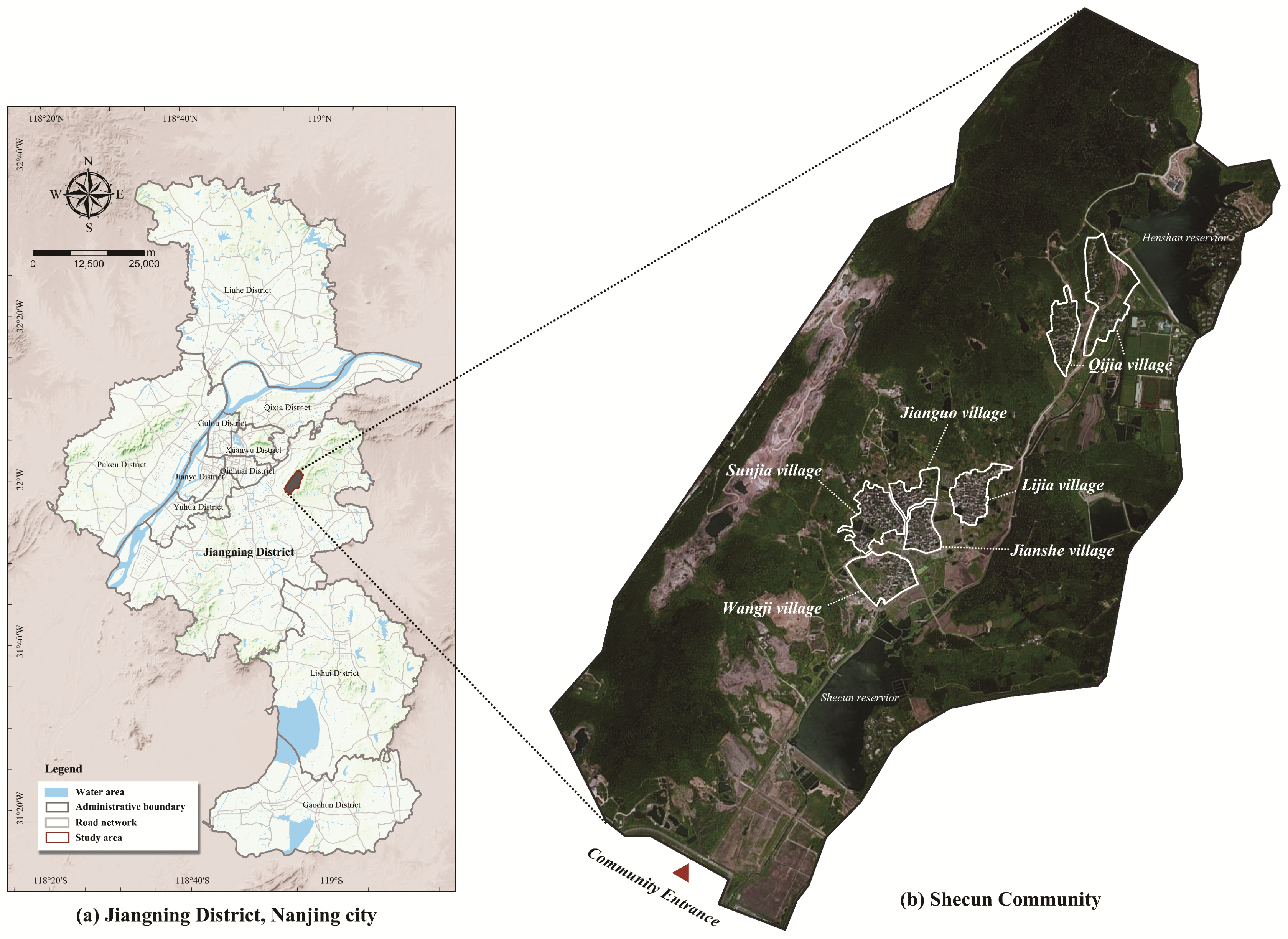
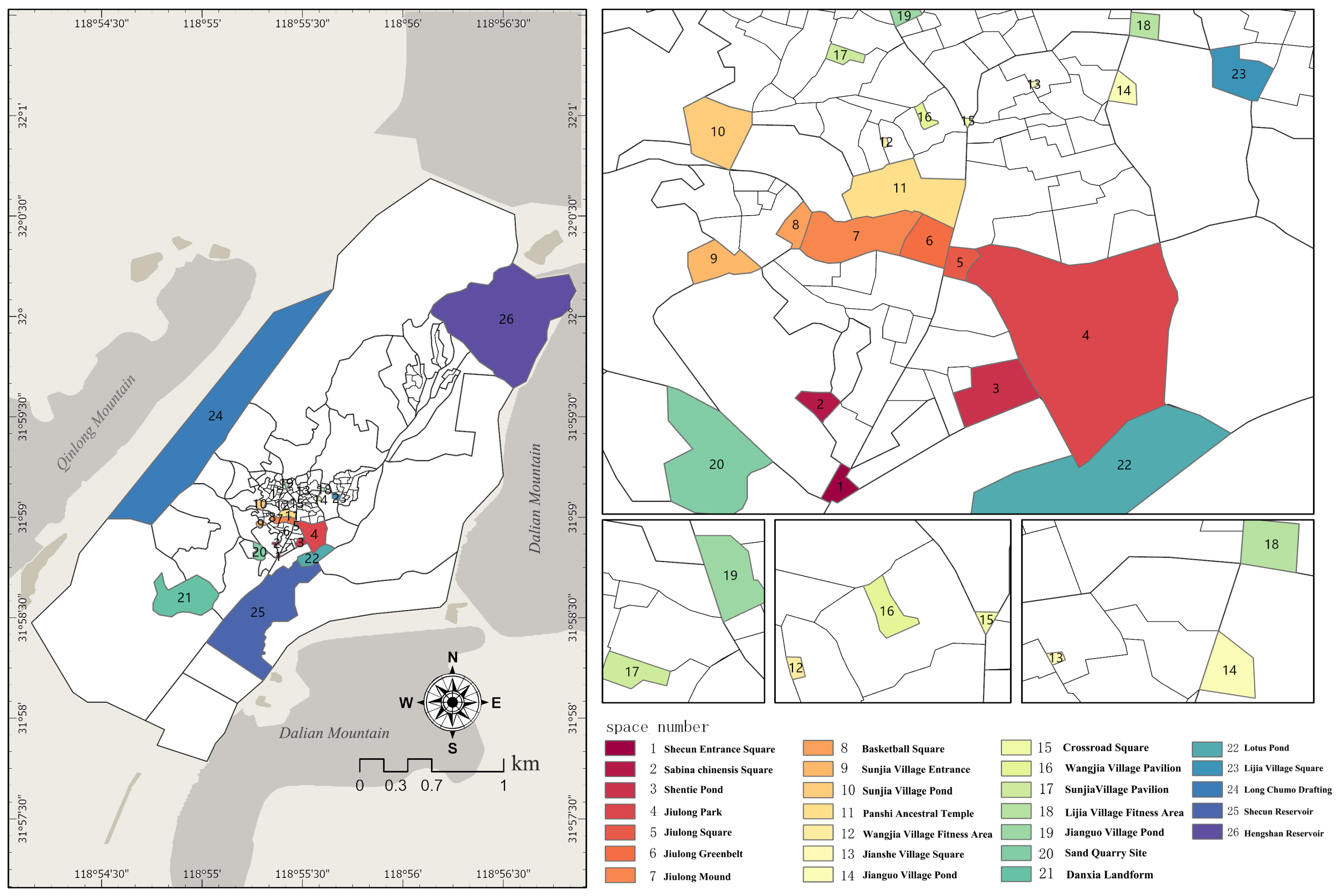
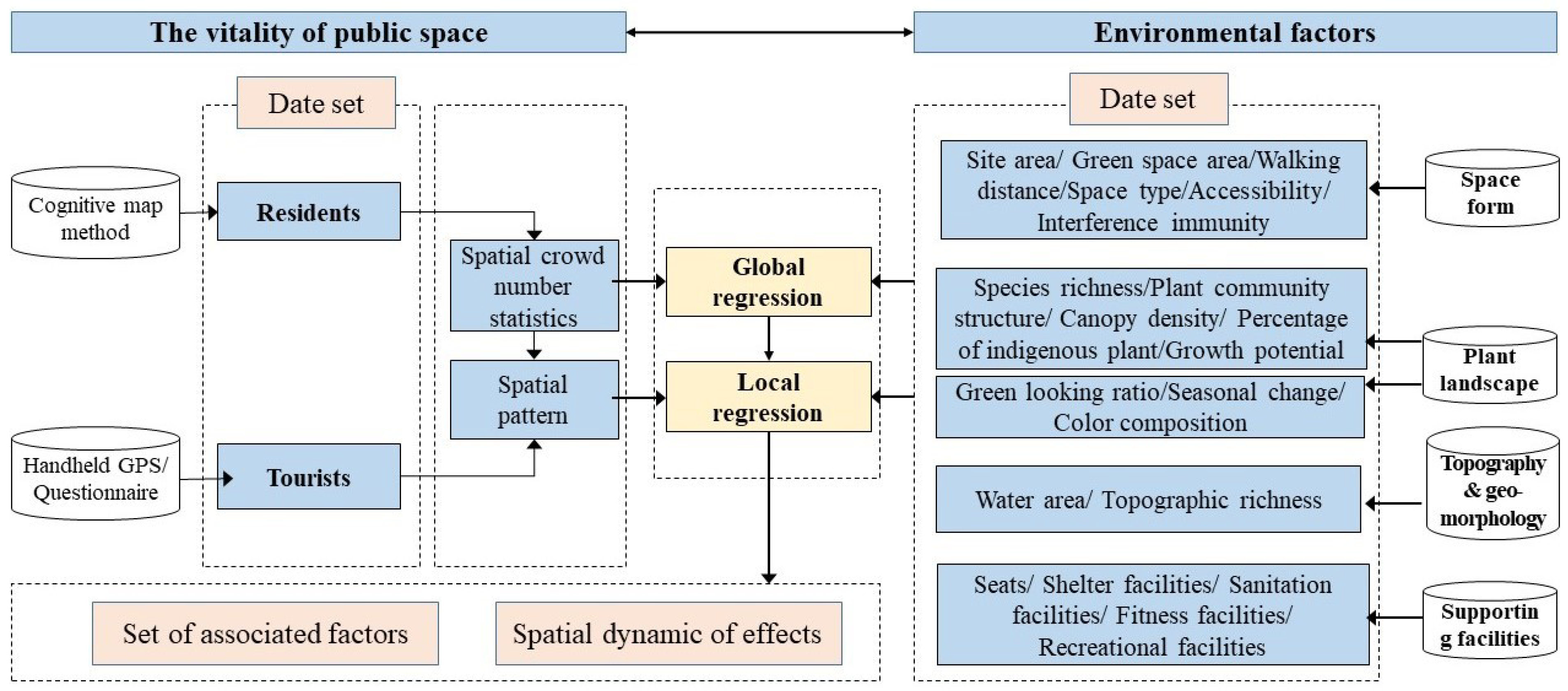
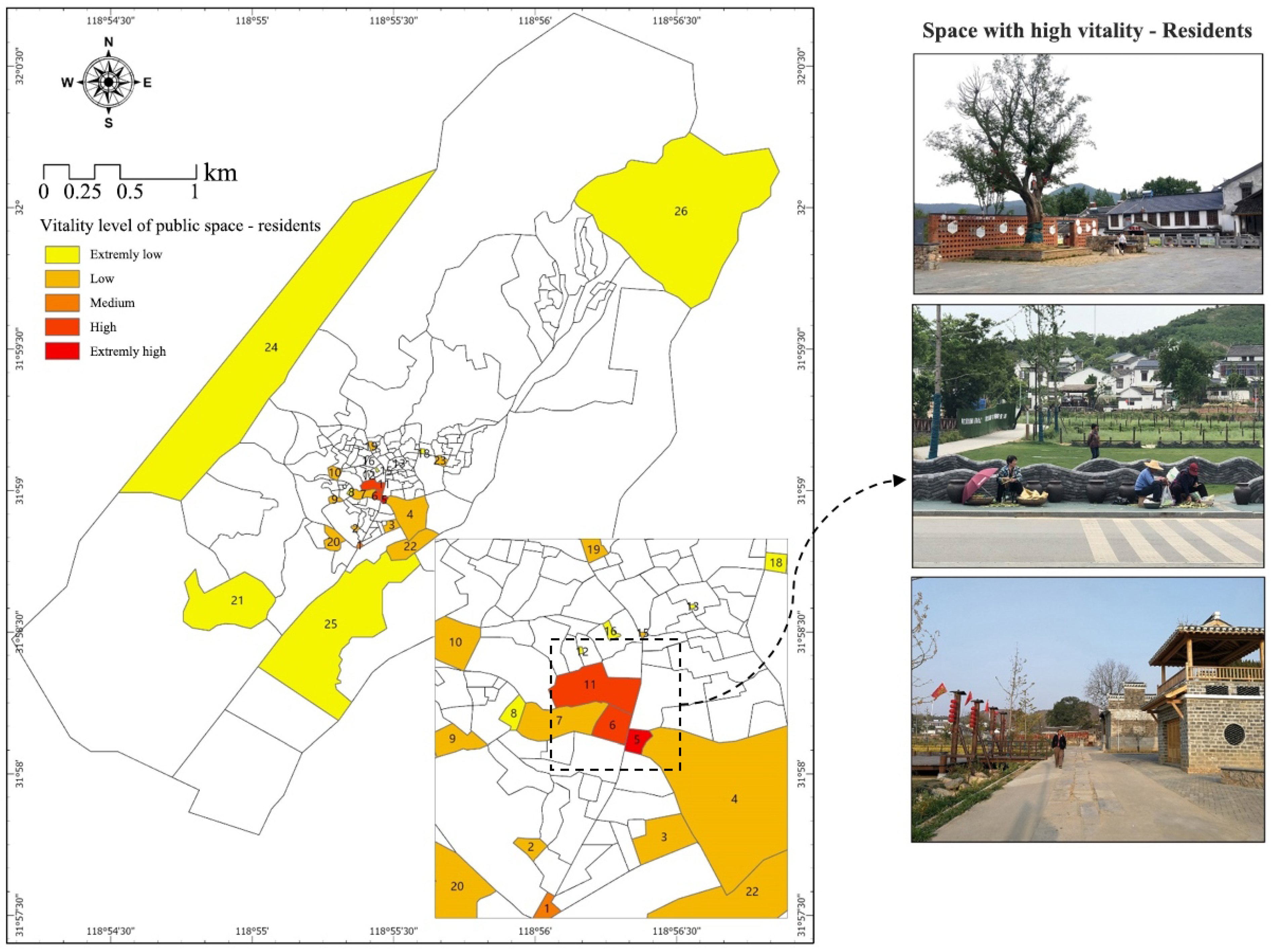
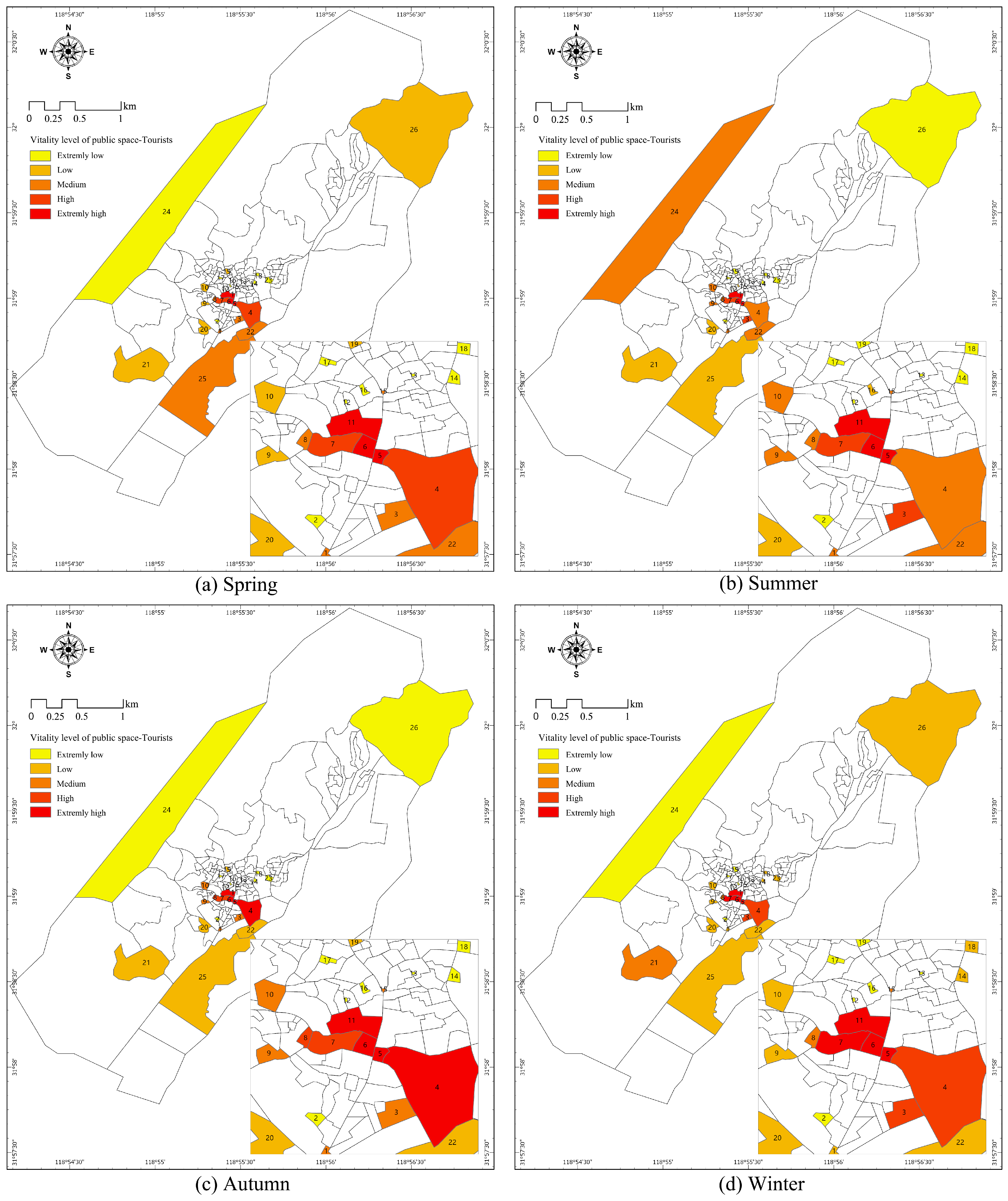
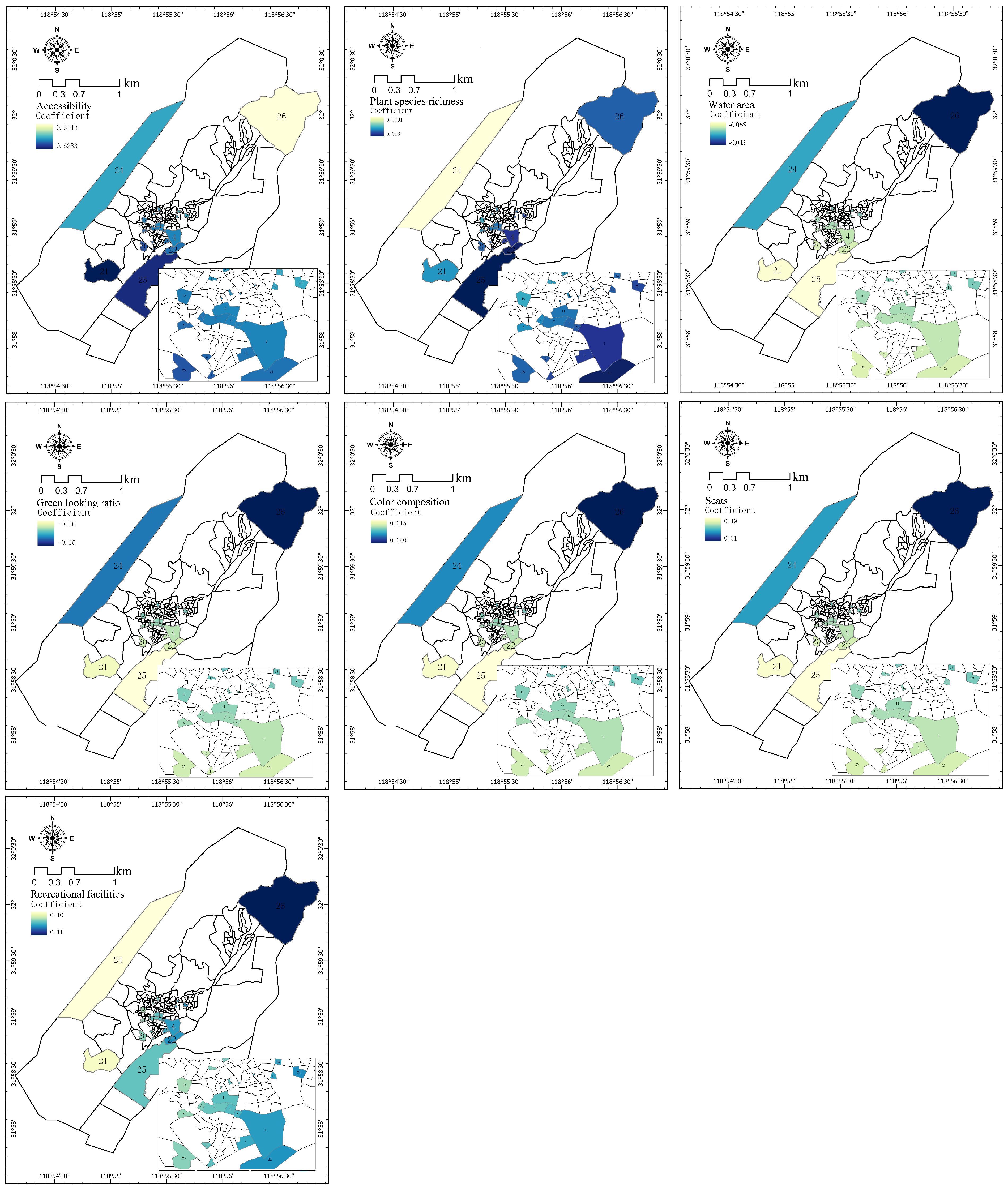
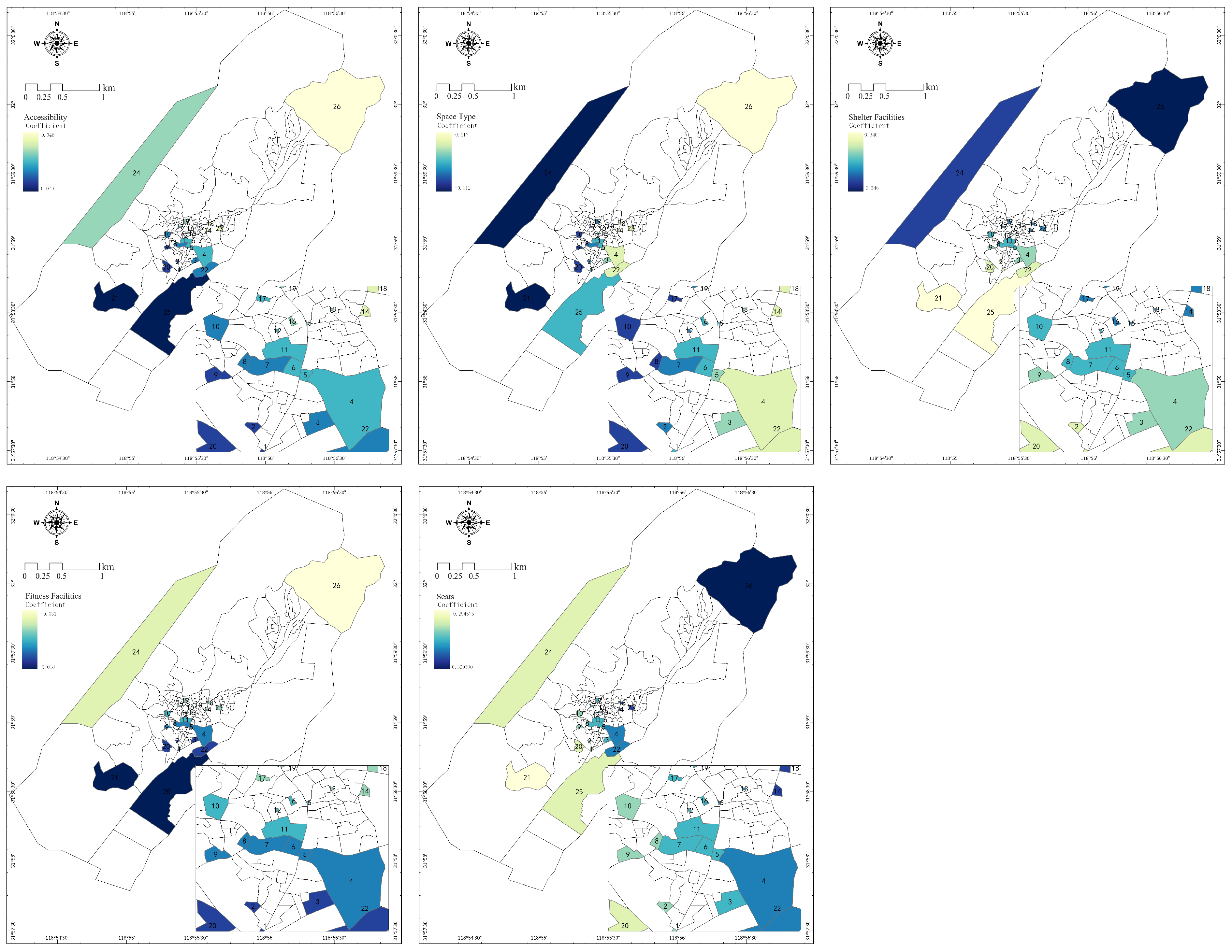
| Categories | Environmental Factors | Content Description |
|---|---|---|
| Space form | Site area | Total site area (square meters) |
| Green space area | Total green space area (square meters) | |
| Walking distance | Length of footpath | |
| Space type | Open (1), semi-open (2), closed (3) | |
| Accessibility | Spatial global integration value | |
| Interference immunity | Is there any ability to isolate from outside traffic and noise? Yes (1)/No (2) | |
| Plant | Plant species richness | Number of species in plant community |
| Plant community structure | Types of plant community structure, including arbor-shrub-grass, arbor-grass, and arbor-shrub, etc. | |
| Plant canopy density | Ratio of the total projected area of tree crown on the ground in sunlight to the total site area | |
| Percentage of indigenous plant | Varieties of indigenous plants/varieties of all plants | |
| Plant growth potential | Plant growth status. Good (3)\Medium (2)\Poor (1) | |
| Green looking ratio | Green proportion | |
| Seasonal change | Richness of seasonal changes of plant communities, including “no change throughout the four seasons”, “change in one season”, and “change in two seasons”, etc. | |
| Color composition | Richness of color composition of plant communities, including “green only” and “multiple colors”, etc. | |
| Topography and geomorphology | Water area | Total water area (square meters) |
| Topographic richness | Is there any terrain? Yes (1)/No (2) | |
| Supporting facilities | Seats | Number/length of seats |
| Shelter facilities | Quantity of shelter facilities (pavilions, corridors, and flower stands, etc.) | |
| Sanitation facilities | Quantity of sanitation facilities (restrooms and trash cans) | |
| Fitness facilities | Quantity of established fitness equipment | |
| Recreational facilities | Children’s amusement facilities, recreational facilities for the elderly (chess and cards rooms, senior citizens activity centers, etc.), and entertainment items |
| Level-One Variables | Level-Two Variables | Moran I | p | z |
|---|---|---|---|---|
| Space form | Site area | 0.02 | 0.01 | 2.61 |
| Walking distance | 0.04 | 0.01 | 2.87 | |
| Green space area | 0.004 | 0.00 | 2.55 | |
| Space type | 0.03 | 0.01 | 2.77 | |
| Accessibility | 0.06 | 0.00 | 3.08 | |
| Interference immunity | 0.025 | 0.01 | 2.63 | |
| Plant landscape | Plant species richness | 0.09 | 0.01 | 2.61 |
| Plant community structure | 0.21 | 0.00 | 0.18 | |
| Plant canopy density | 0.07 | 0.03 | 2.64 | |
| Percentage of indigenous plant | 0.04 | 0.01 | 2.59 | |
| Plant growth potential | 0.02 | 0.66 | 0.43 | |
| Green looking ratio | 0.04 | 0.88 | 0.14 | |
| Seasonal change | 0.06 | 0.01 | 0.17 | |
| Color composition | 0.04 | 0.00 | 2.72 | |
| Topography and geomorphology | Water area | 0.04 | 0.00 | 2.59 |
| Topographic richness | 0.08 | 0.20 | 1.25 | |
| Supporting facilities | Seats | 0.05 | 0.00 | 3.15 |
| Shelter facilities | 0.23 | 0.04 | 2.69 | |
| Fitness facilities | 0.04 | 0.00 | 2.86 | |
| Recreational facilities | 0.17 | 0.01 | 2.67 | |
| Sanitation facilities | 0.05 | 0.00 | 2.56 |
| Model 1 | Variables | Coefficients | Standard Deviations | T Values | p Values | VIF |
| Walking distance | 0.650 | 0.273 | 2.382 | 0.096 | 415.495 | |
| Space type | 6.086 | 40.909 | 0.149 | 0.886 | 6.048 | |
| Accessibility | 1945.690 | 627.056 | 3.103 | 0.004 * | 22.995 | |
| Interference immunity | 142.467 | 88.672 | 1.607 | 0.201 | 17.237 | |
| Plant species richness | −2.949 | 8.081 | −0.365 | 0.734 | 27.883 | |
| Percentage of indigenous plant | −323.309 | 228.943 | −1.412 | 0.247 | 32.632 | |
| Plant growth potential | 57.741 | 26.875 | 2.148 | 0.118 | 7.725 | |
| Green looking ratio | 81.117 | 268.371 | 0.302 | 0.776 | 7.698 | |
| Seasonal change | −77.335 | 38.716 | −1.998 | 0.136 | 10.376 | |
| Color composition | 12.440 | 45.243 | 0.275 | 0.795 | 14.822 | |
| Water area | −0.006 | 0.002 | −2.512 | 0.086 | 394.628 | |
| Topographic richness | 6.788 | 44.645 | 0.152 | 0.884 | 4.476 | |
| Seats | 9.405 | 3.138 | 2.997 | 0.056 | 18.994 | |
| Shelter facilities | −65.975 | 19.257 | −3.426 | 0.035 * | 4.671 | |
| Sanitation facilities | 45.052 | 38.006 | 1.185 | 0.315 | 12.283 | |
| Fitness facilities | 33.438 | 25.292 | 1.322 | 0.272 | 11.058 | |
| AICc | 414.367 | |||||
| Model 2 | Accessibility | 1118.597 | 174.388 | 6.414 | 0.000 * | 1.650 |
| Plant species richness | 9.301 | 2.741 | 3.394 | 0.000 * | 2.976 | |
| Green looking ratio | −209.119 | 206.676 | −2.01 | 0.003 * | 1.416 | |
| Color composition | 96.764 | 22.624 | 4.277 | 0.000 * | 3.288 | |
| Water area | −0.065 | 0.018 | −2.513 | 0.000 * | 2.015 | |
| Seats | 7.527 | 1.209 | 6.221 | 0.000 * | 2.620 | |
| Recreational facilities | −40.876 | 19.439 | −2.102 | 0.009 * | 2.726 | |
| R2 | 0.81 | |||||
| Adj R2 | 0.709 | |||||
| F | 5.90 | |||||
| Sig. | 0.000 | |||||
| AICc | 306.582 | |||||
| Model 1 | Variables | Coefficients | Standard Deviations | T Values | p Values | VIF |
| Walking distance | −0.439 | 0.336 | −1.308 | 0.276 | 610.101 | |
| Space type | −68.940 | 41.467 | −1.663 | 0.189 | 6.023 | |
| Accessibility | 308.755 | 678.061 | 0.455 | 0.674 | 26.058 | |
| Interference immunity | 31.759 | 88.697 | 0.358 | 0.738 | 16.715 | |
| Plant species richness | −11.069 | 8.937 | −1.239 | 0.298 | 33.046 | |
| Percentage of indigenous plant | −127.381 | 259.742 | −0.490 | 0.652 | 40.706 | |
| Plant growth potential | 12.870 | 28.444 | 0.452 | 0.676 | 8.386 | |
| Green looking ratio | 353.722 | 251.460 | 1.407 | 0.248 | 6.550 | |
| Seasonal change | −121.472 | 39.133 | −3.104 | 0.051 | 10.274 | |
| Color composition | 20.492 | 45.069 | 0.455 | 0.675 | 14.254 | |
| Water area | −0.005 | 0.004 | −1.189 | 0.314 | 984.872 | |
| Topographic richness | −78.619 | 44.950 | −1.749 | 0.173 | 4.397 | |
| Seats | 0.260 | 3.446 | 0.075 | 0.942 | 22.199 | |
| Shelter facilities | 42.491 | 17.705 | 2.400 | 0.095 | 3.826 | |
| Sanitation facilities | −62.730 | 51.623 | −1.215 | 0.305 | 21.962 | |
| Fitness facilities | −20.736 | 28.623 | −0.724 | 0.516 | 13.724 | |
| AICc | 497.971 | |||||
| Model 2 | Space type | −55.387 | 33.174 | −1.669 | 0.012 * | 2.285 |
| Accessibility | 834.550 | 308.415 | 2.705 | 0.002 * | 3.195 | |
| Shelter facilities | 82.314 | 82.314 | 5.393 | 0.000 * | 1.685 | |
| Fitness facilities | −16.211 | 12.290 | 12.290 | 0.004 * | 1.500 | |
| Seats | 2.227 | 1.160 | 1.919 | 0.014 * | 1.492 | |
| R2 | 0.829 | |||||
| Adj R2 | 0.73 | |||||
| F | 6.987 | |||||
| Sig. | 0.000 | |||||
| AICc | 321.665 | |||||
| R2 | Adj R2 | AICc | Sigma-Squared MLE |
|---|---|---|---|
| 0.827 | 0.723 | 200.809 | 0.042 |
| R2 | Adj R2 | AICc | Sigma-Squared MLE |
|---|---|---|---|
| 0.89 | 0.84 | 227.9 | 0.106 |
Disclaimer/Publisher’s Note: The statements, opinions and data contained in all publications are solely those of the individual author(s) and contributor(s) and not of MDPI and/or the editor(s). MDPI and/or the editor(s) disclaim responsibility for any injury to people or property resulting from any ideas, methods, instructions or products referred to in the content. |
© 2022 by the authors. Licensee MDPI, Basel, Switzerland. This article is an open access article distributed under the terms and conditions of the Creative Commons Attribution (CC BY) license (https://creativecommons.org/licenses/by/4.0/).
Share and Cite
Zheng, J.; He, J.; Tang, H. The Vitality of Public Space and the Effects of Environmental Factors in Chinese Suburban Rural Communities Based on Tourists and Residents. Int. J. Environ. Res. Public Health 2023, 20, 263. https://doi.org/10.3390/ijerph20010263
Zheng J, He J, Tang H. The Vitality of Public Space and the Effects of Environmental Factors in Chinese Suburban Rural Communities Based on Tourists and Residents. International Journal of Environmental Research and Public Health. 2023; 20(1):263. https://doi.org/10.3390/ijerph20010263
Chicago/Turabian StyleZheng, Jie, Junjun He, and Hongya Tang. 2023. "The Vitality of Public Space and the Effects of Environmental Factors in Chinese Suburban Rural Communities Based on Tourists and Residents" International Journal of Environmental Research and Public Health 20, no. 1: 263. https://doi.org/10.3390/ijerph20010263
APA StyleZheng, J., He, J., & Tang, H. (2023). The Vitality of Public Space and the Effects of Environmental Factors in Chinese Suburban Rural Communities Based on Tourists and Residents. International Journal of Environmental Research and Public Health, 20(1), 263. https://doi.org/10.3390/ijerph20010263










